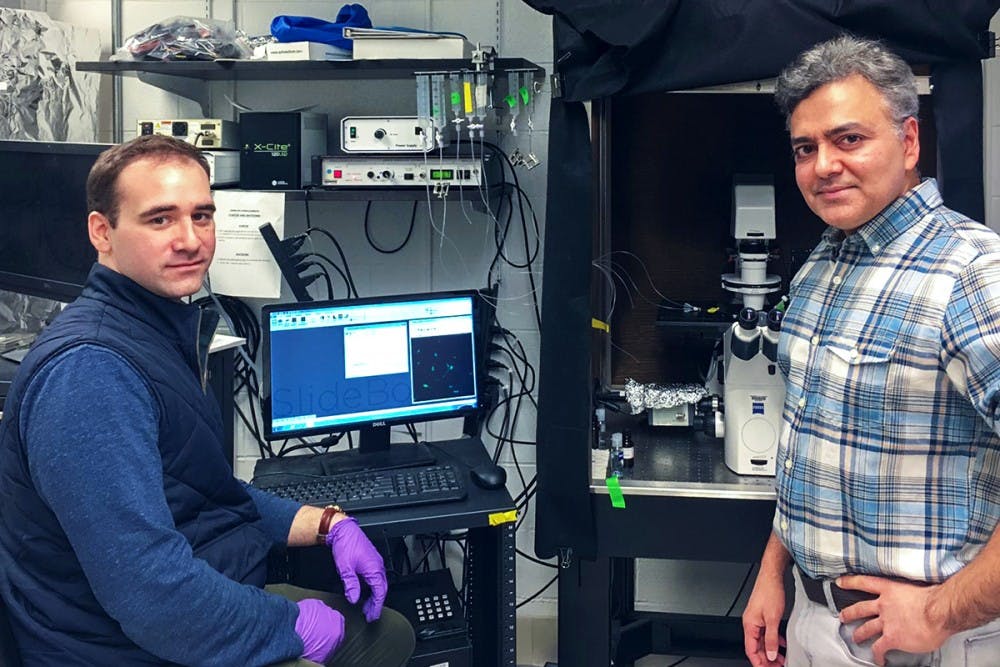Asst. Pharmacology Prof. Bimal Desai recently identified an ion channel that plays a role in the regulation of macrophages — cells which play a significant role in the immune system. The identification of this TRPN7 ion channel provides the opportunity for drug companies to develop new drugs that target the channel, a more effective means of treating inflammation involved in diseases such as Alzheimer’s.
Inflammation is a localized physical condition, usually indicated by redness or swelling. When it occurs, the immune system is activated, dispatching white blood cells to the area of injury or infection. This condition has been implicated in several diseases.
Michael Schappe, a graduate student working in Desai’s lab, said the TRPN7 ion channel regulates the activation of macrophages based on the influx of calcium into and out of the cell. These macrophages are present in all tissue compartments, where they both identify signals due to cellular damage and produce signals indicating damage.
In order to understand the role of the ion channels, Desai stimulated cells with lipopolysaccharide (LPS)— a toxin that normally arouses an inflammatory response from the cells — to measure immune system reaction. The expected inflammatory response with activated macrophages and cytokine signals — immune cell responses — such as IL-1β, was observed in cells expressing TRPN7. However, in cells that were missing this channel, there was a lack of the inflammatory response.
“We demonstrate that the calcium influx which is absolutely necessary for the activation of these macrophages is highly dependent on this channel,” Desai said. “And if you don’t have this channel or when you block it with a small molecule, inhibitor, you prevent the macrophages from getting activated.”
According to Pharmacology Prof. Douglas Bayliss, the ion channel has a fundamental role in inflammation by controlling calcium levels. This discovery is important because it provides a basic understanding of the inflammatory process.
“The importance of the work is manyfold, but there’s sort of a fundamental understanding of how cell signaling and inflammation relies on calcium entry and that identifying this particular ion channel as the way that calcium gets into cells to support the inflammatory process,” Bayliss said. “And ... because it’s a fundamental process, it would be in a lot of cells — immune cells, macrophages, microglia, etc.”
Schappe said their lab wants to gain a better understanding of the role of the TRPN7 channel in the context of different diseases. For instance, inflammation plays an important role in sepsis — a condition where the body reacts to the presence of toxins and other infections. Furthermore, inflammation potentially plays a large role in the progression of neuroinflammatory diseases such as Alzheimer’s disease.
While Desai’s lab is currently collecting preliminary data using mice models for Alzheimer’s disease, the pathology of neuroinflammation is still not completely understood, according to Desai.
“Implying that the inflammatory responses in Alzheimer’s are extremely important either contributes towards the initiation of the disease, but more likely than that is that I think they would accelerate the progression of the disease,” Desai said.
According to Schappe, many of the current drugs for the immune system target different inflammatory signals or cytokines produced by the immune system rather than the source of these signals. Therefore, the identification of this ion channel presents a new possible target for drugs.
Furthermore, drugs directly targeting the ion channel could involve using smaller molecules that would be able to diffuse through the blood-brain barrier — a filtering mechanism between the brain and the rest of the body — more easily, unlike other classes of drugs.
“Since ion channels can be targeted by small molecules or small chemical compounds as opposed to large inhibitory antibodies, which are now very common for anti-inflammatory therapies, it means that hopefully these small drug compounds that can hit ion channels can get access to cells and places in the body that they normally wouldn’t,” Schappe said.
While these new prospects for drug target for inflammation appear promising, there is still a lot that remains unknown about the underlying mechanisms.
“A lot of these aspects are still not well understood, and it’s really the next frontier in Alzheimer’s disease to understand the role of microglia and inflammation in Alzheimer’s,” Desai said.





